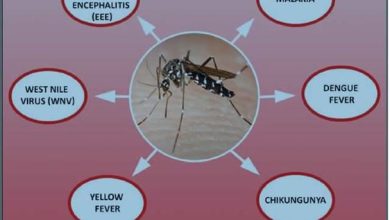MOSQUITO; How To Avoid Mosquito Bite

Mosquitoes are small midge-like flies that constitute the family culicidae. They have a single pair of wings, typically long thin legs and a head featuring a prominent proboscis. Adults may range from 3-9mm. Mosquitoes constitute alot of nuisance, from their itchy irritating bites to the persistent, whiny hum of their buzzing wings that can wake even the soundest of sleepers.
Beyond the nuisance factor, mosquitoes are carriers, or vectors, for some of humanity’s most deadly illnesses, and they are public enemy number one in the fight against global infectious disease. Mosquito-borne diseases cause millions of deaths worldwide every year with a disproportionate effect on children and the elderly in developing countries.
There are more than 3,000 species of mosquitoes, but the members of three bear primary responsibility for the spread of human diseases.
Anopheles mosquitoes are the only species known to carry malaria. They also transmit filariasis (also called elephantiasis) and encephalitis. Culex mosquitoes carry encephalitis, filariasis, the West Nile virus and Aedes mosquitoes, of which the voracious Asian tiger is a member, carrying yellow fever, dengue, Zika virus, and encephalitis.
Behaviour/Habits
Mosquitoes use exhaled carbon dioxide, body odours and temperature, and movement to home-in on their victims. Only female mosquitoes have the mouth parts necessary for sucking blood.
When biting with their proboscis, they stab two tubes into the skin: one to inject an enzyme that inhibits blood clotting; the other to suck blood into their bodies.
They use the blood not for their own nourishment but as a source of protein for their eggs. For food, both males and females eat nectar and other plant sugars.
Mosquitoes transmit disease in a variety of ways. In the case of malaria, parasites attach themselves to the gut of a female mosquito and enter a host as she feeds. In other cases, such as yellow fever and dengue, a virus enters the mosquito as it feeds on an infected human and is transmitted via the mosquito’s saliva to a subsequent victim.
The only silver lining to that cloud of mosquitoes in your garden is that they are a reliable source of food for thousands of animals, including birds, bats, dragonflies, and frogs. In addition, humans are actually not the first choice for most mosquitoes looking for a meal. They usually prefer horses,
cattle, and birds.
How to Stop Mosquitoes
Avoid Stagnant Water: All mosquitoes need to breed, so eradication and population-control efforts usually involve removal or treatment of standing water sources.
Use insect repellent: Use an Environmental Protection Agency (EPA)-registered insect repellent. When used as directed, EPA-registered insect repellents are proven safe and effective, even for pregnant and breastfeeding women.
Cover up: Wear long-sleeved shirts and long pants.
Keep mosquitoes outside: Stay in places with air conditioning or that use window and door screens. If you are not able to protect mosquitoes inside your home or hotel, sleep under a mosquito bed net.
References:
Avoid mosquitoes/features
www.cdc.gov/features/stopmosquitoes/
animals.nationalgeographic.com/animals/bugs/mosquito/
https://en.m.wikipedia.org/wiki/mosquito



